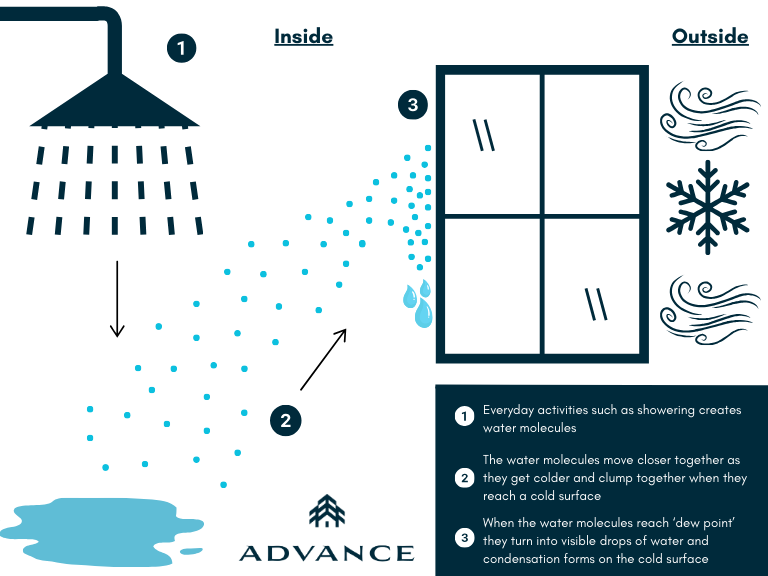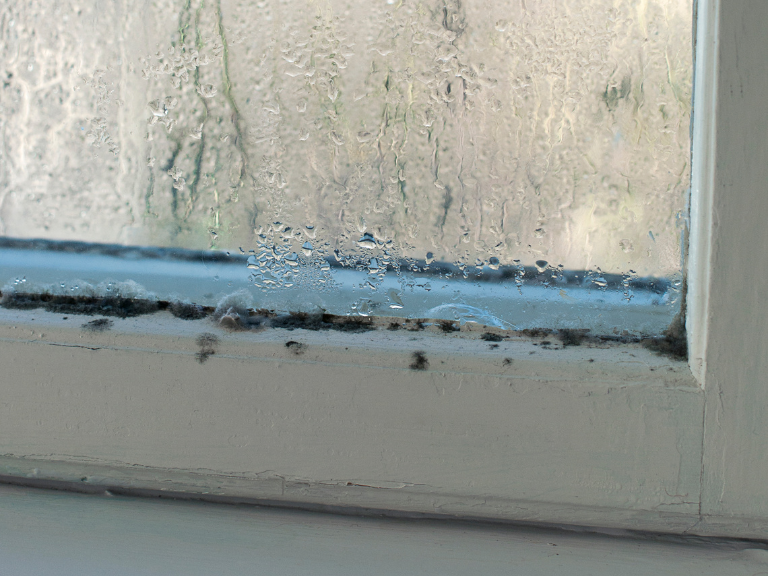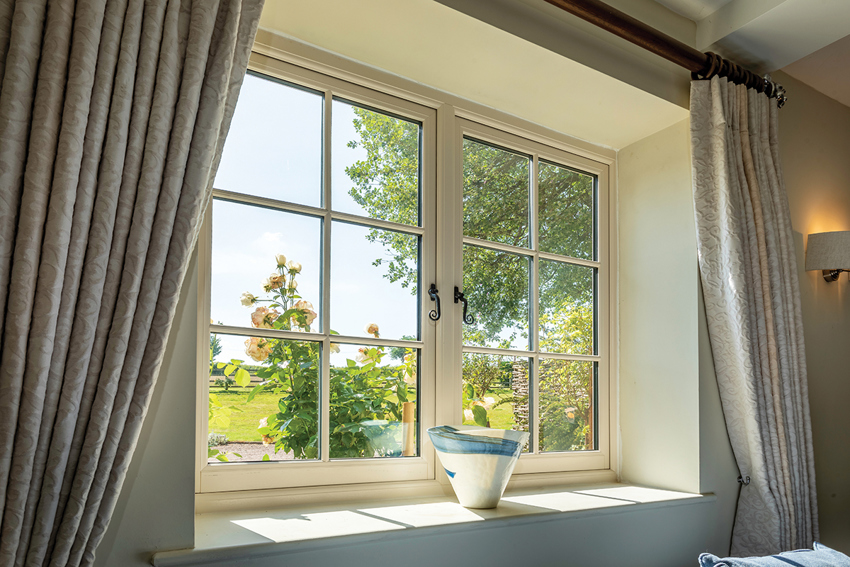What is Condensation & What Causes it?
Condensation is the process where water vapor in the air converts into liquid water upon contact with a cooler surface, such as window glass. It’s a natural phenomenon caused by the difference between indoor and outdoor temperatures. This is most common in winter when warm indoor air meets cold window surfaces, but it can also happen in summer with air-conditioned homes. Other common causes of condensation are everyday activities such as cooking, showering, and drying clothes (which add moisture to the air inside your home), and poor ventilation.

Why Do My New Windows Have Condensation?
If you’ve recently installed new windows, you might be surprised to notice condensation forming. Here’s why this happens:
-
Better Insulation: New, energy-efficient windows are designed to be airtight, which can trap more moisture inside your home. Older windows often allowed for more airflow, unintentionally helping reduce indoor humidity levels.
-
Improved Temperature Differences: Double or triple glazed windows keep the indoor surface of the glass warmer, reducing condensation in many cases. However, the enhanced insulation can also exaggerate humidity imbalances, leading to temporary condensation as your home adjusts to its improved thermal efficiency.
-
Adjusting to New Conditions: Post-installation, your home may experience a short period of acclimatisation, during which indoor humidity levels stabilise. This can sometimes lead to noticeable condensation on your new windows.

When is Condensation Normal?
Condensation, in certain situations, is a natural and harmless occurrence that doesn't indicate a problem with your windows or your home's environment. If the condensation clears up quickly as temperatures stabilise or airflow improves, or there's a slight fogging during extremely cold mornings, especially in older homes, there’s usually no cause for concern.
Let’s explore two key scenarios where condensation is typically not a cause for concern:
Exterior Condensation:
Exterior condensation occurs when the outer surface of your windows cools below the dew point of the air outside. This is especially common during summer mornings or in humid climates. Exterior condensation is actually a sign of highly efficient, well-insulated windows. The panes prevent the transfer of indoor heat to the outside, keeping the outer surface cooler.
Interior Condensation:
Interior condensation is when moisture collects on the inside surface of windows. It’s common under specific conditions and generally harmless if it occurs temporarily. Cold weather and everyday activities such as boiling water and breathing contribute to the humidity.
Why These Types of Condensation Are Harmless:
- No Structural Impact: Exterior condensation doesn't damage your windows or the home’s structure. It’s purely a reaction to weather conditions.
- Short-Lived: Temporary interior condensation dissipates as humidity levels balance, particularly with proper ventilation.
- Indicator of Efficiency: For exterior condensation, it’s often a reassuring sign that your windows are doing their job of maintaining a barrier between indoor and outdoor temperatures.

When Should You Worry About Condensation?
While condensation on windows is often harmless, certain situations suggest underlying problems that may require attention. Persistent or problematic condensation can impact your home’s structure, energy efficiency, and indoor air quality. Here’s a closer look at when condensation becomes a concern:
Persistent Interior Condensation
If you consistently notice moisture on the inside of your windows, it may be a sign of an issue within your home. Persistent interior condensation can lead to mould growth, wood rot and peeling paint or warping.
Condensation Between Panes
Condensation trapped between double- or triple-pane windows is a clear sign of a failed seal. The seal is responsible for keeping insulating gas (like argon or krypton) between the panes to enhance energy efficiency. When the seal is broken, the gas escapes, and the window’s insulating properties are compromised. This can result in: reduced energy efficiency, foggy or hazy windows and risk of further deterioration.
If you have condensation between your window panes and your windows are still covered by warranty, it is highly recommended that you contact the window manufacturer or installer for repair or replacement. However, if you're no longer covered by warranty then you should seriously consider replacing the glass unit or the entire window for improved energy efficiency and aesthetics.
Frost or Ice Formation
The presence of frost or ice on the interior of your windows, particularly during winter, is a sign of excessive indoor humidity combined with poor insulation. This is worrisome as it means your windows are unable to maintain a thermal barrier between the cold outside air and the warm interior, contributing to heat loss and prolonged frost or ice buildup can damage window seals, frames, and nearby structures.
Why Should You Worry About Condensation?
Health Risks from Mould and Mildew
One of the primary concerns with condensation is its potential to promote mould and mildew growth. Mould thrives in damp, humid environments, and condensation provides the perfect breeding ground. Prolonged exposure to mould can significantly impact your health, particularly for vulnerable individuals with respiratory issues, skin irritation or with weakened immune systems.
According to the Centers for Disease Control and Prevention (CDC), long-term exposure to mould can also aggravate chronic respiratory conditions, making it crucial to address condensation and moisture problems as soon as they arise.
How Condensation Damages Your Windows
While condensation itself might seem harmless, if left unchecked, it can cause significant damage to your windows and surrounding structures.
- Wood Rot: Persistent condensation can seep into wooden window frames and sills, leading to rot. This compromises the structural integrity of the window, making it prone to further damage or failure.
- Peeling Paint or Wallpaper: When moisture collects around the window frame, it can cause paint to peel or wallpaper to lift. Over time, this affects the aesthetic appeal of your home and may require costly repairs.
- Foggy Windows: Condensation trapped between double- or triple-pane windows signals a broken seal. This reduces the insulating properties of the window, making it less energy-efficient and more prone to fogging, which also compromises visibility and reduces the window's aesthetic value.

How to Fix Window Condensation?
Condensation can cause significant issues if not managed properly, but there are several ways to reduce or eliminate it. From improving ventilation to choosing the right windows, here are some practical steps to stop condensation from forming, reduce it between window frames, and maintain a healthy and energy-efficient home.
How to Stop Condensation from Forming
Condensation occurs when warm, moist air meets a cold surface, but you can prevent or reduce it with these strategies:
- Reduce Humidity Levels: Condensation is more likely when humidity levels are high. Keep indoor humidity between 30-50% using a dehumidifier. You can also use moisture-absorbing materials like silica gel in particularly damp areas, such as basements.
- Control Moisture-Producing Activities: Limit activities that increase indoor moisture, such as drying clothes indoors, long hot showers, or boiling water without using an exhaust fan. For homes with high humidity (e.g., bathrooms, kitchens), using extractor fans or ventilation systems can significantly reduce moisture levels.
Improve Ventilation to Reduce Condensation
Proper ventilation is crucial in preventing condensation. Without it, moisture becomes trapped in the air, leading to condensation on windows, walls, and other surfaces. Here’s how to improve ventilation in your home:
- Open Windows Periodically: Even in cold weather, opening windows for just a few minutes each day allows fresh air to circulate and helps balance indoor humidity.
- Use Exhaust Fans: In areas with high humidity, like kitchens and bathrooms, exhaust fans are essential to remove moisture from the air. These fans are particularly effective when used during and after cooking or showering.
- Install an HRV or ERV System: A Heat Recovery Ventilation (HRV) or Energy Recovery Ventilation (ERV) system is an energy-efficient solution that exchanges stale indoor air with fresh outdoor air while maintaining the temperature.

How Double Glazing Reduces Condensation
Double glazing is one of the most effective solutions for reducing condensation on windows. Here’s how it works:
- Improved Insulation: Double-glazed windows feature two panes of glass with a layer of air or gas (such as argon) between them. This layer acts as an insulator, keeping the interior surface of the window warmer and reducing the likelihood of condensation forming.
- Enhanced Energy Efficiency: Because double glazing reduces heat loss, your home remains warmer, which means the temperature difference between the indoor air and window glass is smaller, further preventing condensation from forming.
Conclusion
Condensation on windows, while a common occurrence, can often be more than just an inconvenience. While some level of condensation is normal, especially in colder months or in homes with improved insulation, persistent or problematic condensation can lead to serious issues. From health concerns like mould and mildew growth to damage to your windows and surrounding structures, it’s important to recognise when condensation becomes a problem.
By understanding the causes of condensation - such as temperature differences, poor ventilation, and high humidity levels - you can take the necessary steps to prevent it. Simple solutions like using dehumidifiers, improving ventilation, and opting for double-glazed windows can make a significant difference. In cases where condensation signals a failed window seal or persistent moisture buildup, it's crucial to address the problem promptly to avoid costly repairs and health risks.
Taking proactive measures to manage condensation not only helps maintain the integrity of your windows but also ensures a healthier and more comfortable living environment. So, whether you're dealing with new windows or an older home, staying ahead of condensation issues will help you preserve your home’s condition and protect your well-being.

In need of some new windows? Contact Advance today to explore your options and discover high-quality, energy-efficient solutions designed to reduce condensation, improve ventilation, and enhance the comfort of your home.















